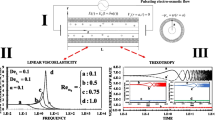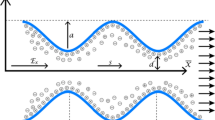Abstract
The dynamic responses of the electrorheological fluid in steady pressure flow to stepwise electric fields are investigated experimentally. First of all, the transient responses of the ER fluid under various electric field strengths and flow velocities are obtained from the pressure behaviors in the flow channel with two parallel-plate electrodes. The response times are exponentially decreased with the increase of the flow velocity and the decrease of the electric field strength. Next, the relationship between the dynamic pressure behaviors of the ER fluid and the cluster structure formation processes of the ER particles is investigated using the flow visualization technique. Through the comparison study, it is verified that the dynamic responses of the ER fluid in the flow mode are mainly caused by the cluster densification process in the competition of the electric field-induced particle attraction and the hydrodynamic force, unlike those in the shear mode determined by the particle aggregation process.










Similar content being viewed by others
References
Bonnecaze RT, Brady JF (1992) Dynamic simulation of an electrorheological fluid. J Chem Phys 90:2183–2202
Bullough WA, Makin J, Firoozian R, Johnson AR, Hosseini-Sianaki A (1994) The effect of solid fraction concentration on the time domain performance of an ER fluid in the shear mode. Int J Mod Phys B 8:2855–2876
Choi SB, Bang JH, Moon SH (1998) Control characteristics of automotive ABS featuring electro-rheological valves. Trans Kor Soc Mech Eng (A) 22:1874–1883
Ginder JM (1993) Diffuse optical probes of particles motion and structure formation in an electrorheological fluid. Phys Rev (E) 47:3418–3429
Ginder JM, Ceccio SL (1995) The effect of electrical transients on the shear stresses in electrorheological fluids. J Rheol 39:211–234
Hosseini-Sianaki A, Bullough WA, Firoozian R, Makin J, Tozer RC (1992) Experimental measurements of the dynamic torque response of an electrorheological fluid in the shear mode. Int J Mod Phys (B) 6:2667–2681
Jordan TC, Shaw MT, McLeish TCB (1992) Viscoelastic response of electrorheological fluids: II field strength and strain dependence. J Rheol 36:441–463
Klingenberg DJ, Zukoski CF (1990) Studies on the steady-shear behavior of electrorheological suspensions. Langmuir 6:15–24
Maemori KI, Morihara T (1996) Optimum design of hydraulic shock absorber using electrorheological fluid. Trans Jap Soc Mech Eng (C) 62:4224–4229
Maemori KI, Naito H (1996) Multi-objective optimization of a vibration system with a damper using electro-rheological fluid. Trans Jap Soc Mech Eng (C) 62:1726–1730
Martin JE, Odinek J (1995) Aggregation, fragmentation, and the nonlinear dynamics of electrorheological fluids in oscillatory shear. Phys Rev Lett 75:2827–2830
Rhee EJ, Park MK, Yamane R, Oshima S (2003) A study on the relation between flow characteristics and cluster formation of electrorheological fluid using visualization. Exp Fluids 34:316–323
See H, Doi M (1992) Shear resistance of electrorheological fluids under time-varying electric fields. J Rheol 36:1143–1163
Takimoto J, Minagawa K, Koyama K (1996) Numerical study of the response time of ER suspensions. Int J Mod Phys (B) 10:3037–3044
Tanaka K, Koyama K, Yoshida T (1993) Transient stress response of ER suspension. J Rheol 37:555
Tanaka K, Sahashi A, Akiyama R (1995) Scaling behavior of response times of electrorheological suspensions with cation exchange resin particles. Phys Rev (E) 52:3325–3328
Tanaka K, Nakamura K, Akiyama R (2000) Time scales for structural formation in an electrorheological suspension probed by optical and electrical responses. Phys Rev (E) 62:5378–5382
Tao R, Jiang Q (1994) Simulation of structure formation in an electrorheological fluid. Phys Rev Lett 73:205–208
Tian Y, Meng Y, Wen S (2004) Dynamic responses of zeolite-based ER fluid sheared between two concentric cylinders. J Intel Mat Syst Str 15:621–626
Tian Y, Li C, Zhang M, Meng Y, Wen S (2005) Transient response of an electrorheological fluid under square-wave electric field excitation. J Colloid Interf Sci 288:290–297
Tomiuga T, Okamoto K, Madarame H (1999) Visualization study on chain structure in electro-rheological fluids. Int J Mod Phys (B) 13:1783–1790
Tsukiji T, Hori KI (1999) Pressure response of ER fluids between two parallel-plate electrodes. Int J Mod Phys (B) 13:1917–1924
Valdez MA, Manero O (1997) Rheology of colloidal particles in a confined channel under shear flow by brownian dynamic simulations. J Colloid Interface Sci 190:81–91
Wang Z, Lin Z, Fang H (1998) Dynamic response times of electrorheological fluids in steady shear. J Appl Phys 82:1125–1131
Winslow WM (1949) Induced vibration of suspension. J Appl Phys 20:1137–1140
Xu J, Dong X, Zhang LF, Jiang YG, Zhou LW (2002) Diffusing wave spectroscopy method based on high-speed charge coupled device for nonergodic systems of electrorheological fluids. Rev Sci Instrum 73:3575–3578
Author information
Authors and Affiliations
Corresponding author
Rights and permissions
About this article
Cite this article
Nam, Y.J., Park, M.K. & Yamane, R. Dynamic responses of electrorheological fluid in steady pressure flow. Exp Fluids 44, 915–926 (2008). https://doi.org/10.1007/s00348-007-0449-1
Received:
Revised:
Accepted:
Published:
Issue Date:
DOI: https://doi.org/10.1007/s00348-007-0449-1




